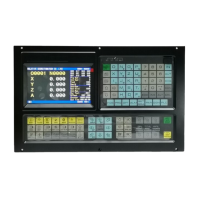TOMATECH AUTOMATION
C ● ● ● ● ● ●
D ● ● ● ● ● ●
E ● ● ● ● ● ● ● ● ● ● ● ●
4.2 Signal specification
Sensor A, B, C, D: only check the tool, and are not any start signals
Sensor E: it executes the inductive once when one tool change is executed, which makes
the
tool pot stop and the start signal be locked. When the tool pot rotates to the required
position, Sensor is inductive, i.e. the electromagnet to control the tool pot rotation is
turned off, which makes the tool stop rotation and start the electromagnet to lock the
tool pot to ensure that the tool pot is locked.
Sensor F: releasing/lock confirmation signal. When it is not inductive, the tool pot is
released, at
the time, the tool pot is started to rotate. When it is not inductive, the tool pot is locked,
i.e. the tool change is completed.
Sol A: control the tool pot releasing/locking
Sol B: control the tool pot rotation(CW/CCW)
4.3 Tool change process description
Example: No. 1 tool is changed into No. 4 tool
Step 1: Sol A is turned on(tool pot is released)
Step 2: Ensure Sensor F is not inductive, Sol B is turned and the oil hydraulic motor
rotates
Step 3: check the tool signal(Note: Sensor E is inductive for No. 1, 2, 3 tool, does not
execute the
locking operation when the tool pot does not reach No. 4 tool). When No. 3 tool signal is
confirmed,
Sensor E preparatory operation should be set to make the tool pot rotate to No.4 tool, at
the time,
Sensor E is inductive, i.e. Sol B is turned on, the tool pot stops rotation and Sol A makes
the tool pot
be locked.
332
Ⅲ Connection
2.8.3 Machine zero return
� Relative signal
DECX: X deceleration signal;
DECY: Y deceleration signal;
DECZ: Z deceleration signal;
DEC4: 4th deceleration signal;
DEC5: 5th deceleration signal;
PCX: X zero signal;
PCY: Y zero signal;
PCZ: Z zero signal;

